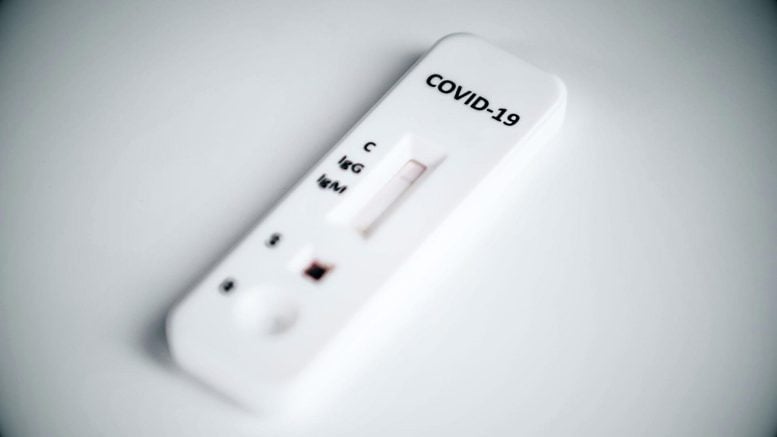
Lateral flow tests for COVID-19 in children, analyzed in a study of 17 reports, show lower than expected sensitivity and high specificity, challenging their effectiveness in school settings.
Lateral flow tests for COVID-19 fall short of minimum criteria set by WHO and US and UK device regulators Findings cast doubt on effectiveness of their use for widespread testing in schools.
The performance of lateral flow (antigen) tests commonly used to detect COVID-19 infection in children falls short of the minimum criteria set by the World Health Organization (WHO) and US and UK device regulators, finds a pooled data analysis of the available evidence on 8 different tests, published in the journal BMJ Evidence-Based Medicine.
The findings cast doubt on the effectiveness of their use in widespread testing in schools, suggest the researchers.
Lateral flow (antigen) tests have been widely used to pick up children with SARS-CoV-2, the virus responsible for COVID-19 infection, in schools and kindergarten.
Review of Lateral Flow Test Accuracy
The accuracy of these tests in adults is highly variable and often substantially lower than that reported by manufacturers. But it’s not clear how well they perform when used in children in real life.
In a bid to plug this knowledge gap, the researchers trawled research databases and pre-print servers, looking for studies published between 2020 and May 2021 that compared the accuracy of lateral flow antigen tests with swab (PCR) tests, considered the reference standard, in children.
They found 17 relevant studies (12 peer-reviewed journal studies and 5 pre-print studies), published in English. These involved 6355 children and 8 antigen tests from 6 different brands.
In 11 of the test evaluations, samples were collected from the throat and nose; in the rest samples were collected only from the nose. One study involved supervised collection of samples; all the others involved sample collection by trained staff.
Overall Test Performance and Implications
The data from all 17 studies were pooled to measure the diagnostic sensitivity and specificity of these tests. Sensitivity indicates how well a test picks up people who have a disease/infection; specificity indicates how well a test picks up those who don’t.
The overall sensitivity of the evaluated tests was just over 64%; the overall specificity was just over 99%. The researchers then restricted the analyses to children with and without symptoms.
Comparing Symptomatic and Asymptomatic Test Sensitivity
Among children with symptoms, the pooled diagnostic sensitivity was just under 72% and the pooled diagnostic specificity was just under 99%, based on 3413 children in 13 studies.
Among children without symptoms the pooled diagnostic sensitivity was just over 56% while the pooled diagnostic specificity was just over 98.5%, based on 2439 children in 10 studies.
These observed differences in test performance between children with and without symptoms show that sensitivity and specificity are not inherent test characteristics, say the researchers.
Limitations and Variability in Test Performance
They highlight certain limitations to their findings. Inadequate reporting precluded quality assessment of most of the studies. And the review was restricted to 8 tests: there are more than 500 lateral flow tests for professional use on the market.
None of the included studies assessed sample collection by untrained people or self-testing, which likely worsens performance. And the findings might not be applicable to future SARS-CoV-2 variants or vaccinated children either, the researchers acknowledge.
Conclusions on Lateral Flow Tests
But they write: “Sensitivity estimates of antigen tests varied broadly among studies and were substantially lower than reported by manufacturers,” although the intended use of most tests is limited to people with symptoms, so performance data reported by manufacturers usually refer only to those with symptoms, they add.
“Less variation and only minor discrepancies to performance claims by manufacturers were observed for specificity estimates across studies.”
But they conclude: “Taking into account test-specific pooled results, no test included in this review fully satisfied the minimum performance requirements as recommended by WHO…, the US [Food and Drug Administration…or the Medicines and Healthcare products Regulatory Agency (MHRA) in the UK.
“This may affect the planned purpose of the broad implementation of testing programs.”
The Broader Impact of Lateral Flow Tests
While lateral flow tests complement PCR tests, extend test capacity, and come into their own when a short turnaround is essential, they nevertheless “come at the price of lower diagnostic accuracy, most notably a lower diagnostic sensitivity, which increases the risk of missing cases, including those with pre-symptomatic infection who have yet to enter the most infectious period,” they note.
Whether this can be compensated for with frequent testing remains a moot point, they add.
Reference: “Evidence synthesis: Diagnostic accuracy of rapid point-of-care tests for diagnosis of current SARS-CoV-2 infections in children: a systematic review and meta-analysis” by Naomi Fujita-Rohwerder, Lars Beckmann, Yvonne Zens and Arpana Verma, 18 January 2022, BMJ Evidence-Based Medicine.
DOI: 10.1136/bmjebm-2021-111828









MSM is trying to make fun of people wanting to protect themselves with cheap and proven drugs. Ivermectin has been FDA approved for human use since 1996. It also beats Pfizer’s new wonder drug hands down, and costs next to nothing. Ivermectin doesn’t make tons of money. So they know the Covid shot is on its final gasp, so they take it add something different to it, rebrand under another name and charge 20 times what they would for ivermectin. I cannot wrap my head around this nonsense. When I explain this to my relatives they label me as crazy and ask me if I know better than science. I don’t make up these information out of my ass. All this information is true and proven. For some people it is near impossible for them to wake up. They are comfortable in their clown world life. If you want to get Ivermectin you can visit truthpharmacy.com